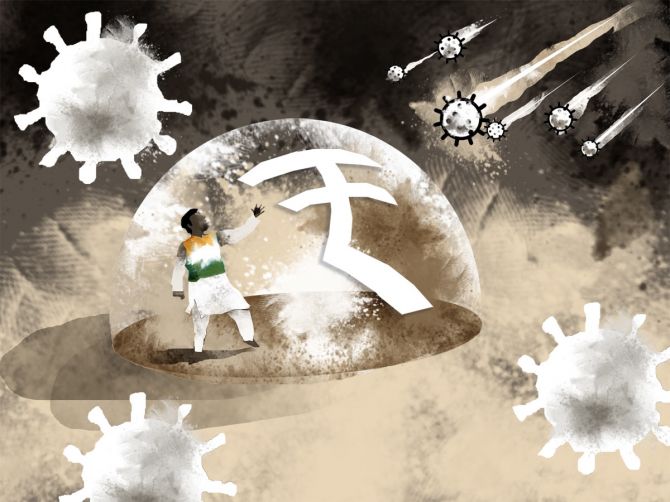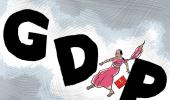The government kept its nerve in the face of a massive shock.
It chose not to resort to a massive fiscal stimulus.
It focused instead on providing liquidity support and easing restrictions on movement in stages, observes T T Ram Mohan.

Did the government get its handling of the pandemic right? That is the question many will have on their minds as the Indian economy recovers from what was touted as the 'worst crisis of the century'.
There are two parts to the question.
One, was the government right to enforce a nation-wide lockdown last March?
Two, having imposed the lockdown, did it take the right steps to minimise the damage to the economy?
The definitive answer to the first part may not be known for a long time.
Almost everything about the virus is up for debate at the moment.
Is it transmitted mostly through close personal contact?
Does social distancing by law help?
Is masking of any great use? Are the tests for the virus reliable?
Will vaccines prove effective enough and without significant side effects?
What answer you get to these questions depends on which scientists you ask or what research papers you choose to believe.
The Indian government opted for a complete lockdown last March.
It judged that the priority was to limit the spread of the virus until adequate capacity was created in the healthcare system.
Armchair commentators are free to contend that the health outcomes would not have been different sans a stringent lockdown.
They may say that livelihoods should have got a higher priority than they did.
However, most people would agree that no government could have taken the risks involved in such an approach this March.
It is the answer to the second part that is more contentious.
In the initial months of the pandemic, there was a chorus of demands for an extra-strong fiscal response.
Former chief economic adviser Arvind Subramanian and economist Devesh Kapur exhorted the government to spend an extra 5 per cent of gross domestic product.
Former Reserve Bank of India governor Raghuram Rajan was of the view that India's fiscal stimulus was inadequate and the strategy of conserving the fiscal stimulus for a later date was self-defeating.
Nobel Laureate Abhijit Banerjee urged the government to emulate advanced economies that had resorted to a bigger stimulus.
Leading economists based in India echoed these views.
The Indian government chose not to be guided by this barrage of advice.
It has preferred to limit the additional fiscal stimulus for the year in the range of 2-2.5 per cent of GDP.
One can discern the considerations that influenced this approach.
One, the best way to contain the impact of the pandemic on the economy was to end the full lockdown at the earliest.
Two, India's fiscal position was already difficult.
A substantial expansion in the fiscal deficit would have implications for the sovereign rating and for an early return to fiscal consolidation post the pandemic.
Three, with economic activity on hold, the weakest firms would go to the wall but the majority could survive with enough liquidity support.
Four, increasing aggregate demand at a time when supply was severely constrained would not help -- cash transfers would be saved, not spent, and spending on infrastructure would remain on paper.
Five, a large fiscal stimulus would make it difficult for the RBI to contain inflation within the upper limit of 6 per cent.
The RBI's latest inflation forecast shows that we are perilously close to having an inflation rate of over 6 per cent in three successive quarters, which would be a breach of the RBI's mandate.
Six, domestic and foreign investors could be reassured about the long-term economic outlook by announcing major reforms.
Events thus far have vindicated the government's approach.
All indicators point to a faster revival in growth than forecast earlier.
The contraction in FY 2020-2021 Q2 GDP has been lower than expected. The RBI expects growth to turn positive in Q3 itself.
It is the banking sector that provides the best proof of the resilience of the Indian economy.
Following the lockdown, the RBI announced a three-month moratorium on the servicing of term loans last March.
This was extended by another three months up to end August.
When the moratorium period ended, the RBI announced a policy on restructuring of loans.
Pundits saw the moratorium and the loan restructuring as leading up to another mountain of bad loans in the future.
The RBI's Financial Stability Report (July 2020) projected an increase in the ratio of non-performing loans to total loans from 8.5 per cent in March 2020 to 12.5-14.7 per cent by March 2021.
The outcomes in respect of both, the moratorium and loan restructuring, have taken bankers by surprise.
Investment bank Jefferies estimates that moratorium loans accounted for only 31 per cent of all loans in Phase I and 18 per cent in Phase 2.
If the prospects were as gloomy as they were made out to be, why did more firms not opt for loan moratorium? Perhaps the gloom was exaggerated by firms and pundits alike?
Banks expect restructured loans to be 2-3 per cent of the loan bank, way below the 5-6 per cent they had expected when the scheme was announced.
Retail borrowers and small and medium enterprises have opted for loan restructuring but not many large firms.
Bankers are astonished that even in the hotel sector, which is among the worst hit, not many firms have asked for loan restructuring.
Analysts say that large firms wish to avoid the stigma that goes with restructured loans.
Restructuring is perceived as default by rating agencies and would make it difficult for firms to access the international markets.
Some of the better-rated firms are able to access funds at low rates through the commercial paper market and are using these to service their loans.
These may be a part of the answer.
But they cannot explain how so many firms expect to get by without restructuring in the face of a huge shock.
The explanation must be that the shock is not as great as feared.
In not opting for loan restructuring, firms are signalling that we are over the hump.
CRISIL now expects the non-performing loans to total loans ratio to be 11-11.5 per cent, which is below the lower range of the RBI forecast.
If further proof of the resilience of the Indian economy were needed, look at the inflows of foreign capital.
In April-September 2020-2021, foreign institutional investor inflows were $8 billion, compared to $7.2 billion in the same period in the previous year.
About half the FII inflows in November are reported to have gone into the banking sector.
It's a sure sign that FIIs see the banking sector and the economy reviving strongly.
Gross FDI inflows were $40 billion and $36 billion, respectively in the two periods.
The pandemic has done little to dampen foreign investor confidence in the Indian economy.
The government kept its nerve in the face of a massive shock.
It chose not to resort to a massive fiscal stimulus.
It focused instead on providing liquidity support and easing restrictions on movement in stages.
Give credit where it is due. The government got its policy response to the pandemic right.
Feature Presentation: Aslam Hunani/Rediff.com











